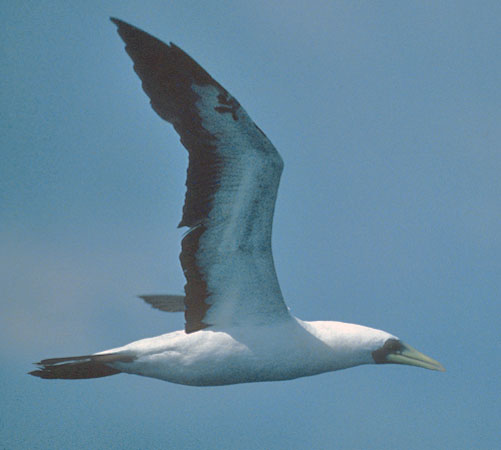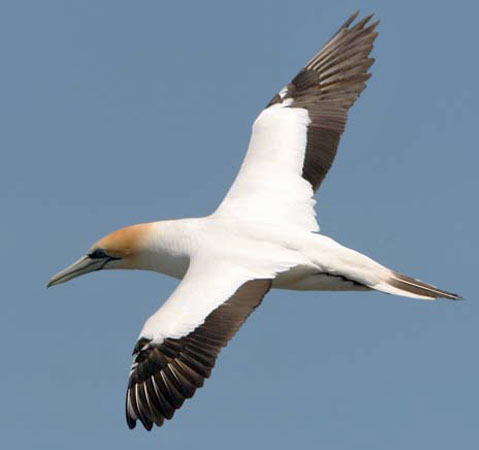| |
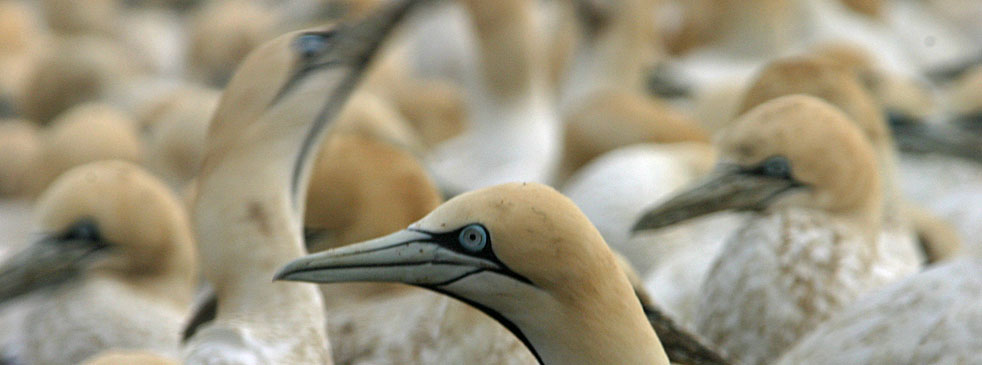 |
BOOBIES Sulidae |
- 10 species in tropical and temperate oceans worldwide
- DR personal total: 9 species (90%), 9 photo'd
|
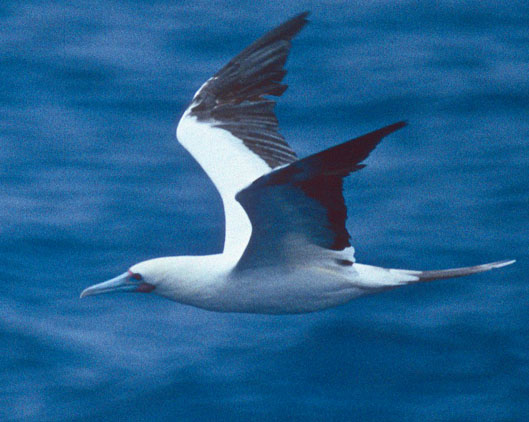 The Sulidae are large seabirds found around the globe, primarily concentrated towards equatorial waters. All species are strictly marine birds, feeding primarily on fish, and they come ashore only to nest or roost. Sulids are built for a wandering life at sea, and after fledging may not return to the breeding islands for years. They have a buoyant flight on long, strong wings; a maneuverable long wedge-shaped tail; and a cigar-shaped body with a long, sturdy, fish-eating bill (Carboneras 1992). The Sulidae are large seabirds found around the globe, primarily concentrated towards equatorial waters. All species are strictly marine birds, feeding primarily on fish, and they come ashore only to nest or roost. Sulids are built for a wandering life at sea, and after fledging may not return to the breeding islands for years. They have a buoyant flight on long, strong wings; a maneuverable long wedge-shaped tail; and a cigar-shaped body with a long, sturdy, fish-eating bill (Carboneras 1992).
The three closely-related gannets (genus Morus) breed and summer well beyond the tropics, at colonies in the north Atlantic, or southern Australia & New Zealand, or southern Africa — a small slice of colony of Cape Gannet in South Africa is shown above. The remaining 7 species are boobies (genus Sula) generally restricted to tropical seas. The largest gannet may be 5 times heavier than the smallest booby — Red-footed Booby (below, confronting a much larger Brown Pelican Pelecanus occidentalis). Red-footed Booby may be the most pelagic of them all, and is the only species with color morphs. A white-morph adult Red-footed Booby (left) was photographed in the eastern tropical Pacific; the dark-morph Red-foot (below) was a vagrant to Monterey Bay.
|
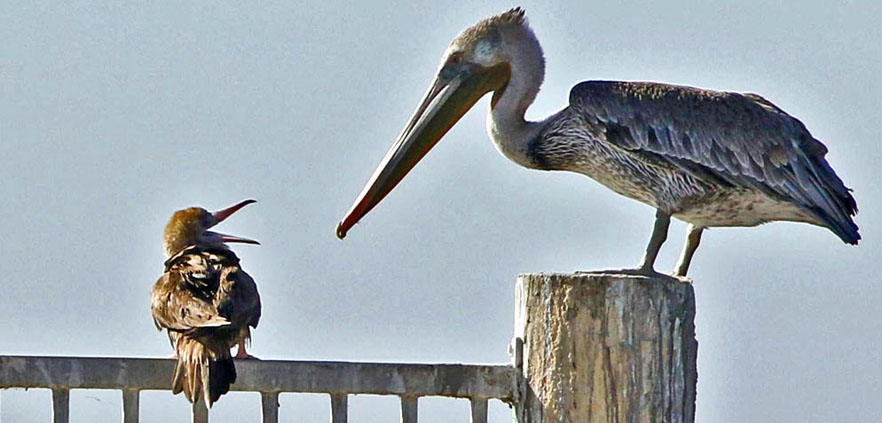 |
Most of my sulid experiences are with tropical boobies, and my first booby was when I was 19 years old. Blue-footed Booby (both photos below) appears in California in erratic, unpredictable "invasions" which often begin at the Salton Sea in the desert of southern California. The 1971 invasion peaked in September but word did not reach me at my northern California boarding school until months later. On the first weekend of November, three friends and I decided to pile into my little red VW bug and drive all night to the Salton Sea. This was my first long "chase" trip for a rare bird. We were lucky: one was still on the Salton Sea shore (below left; a good summary on those early invasions are in McCaskie (1970). Another huge invasion occurred five years later in 1976, and one Blue-foot wandered all the way up the Sierran foothills to New Hogan Reservoir, Calaveras County (photo below right shows me and the booby). That lost bird appeared 15 Sep 1976 and stayed a month; it was found dead in mid-October (Elliott 1976). The name "booby" comes from a British seaman's slang for "stupid" — on nesting island the first sailors could walk right up to the birds and hit them over the head. [Indeed, keeping breeding islands free of people and introduced predators is a key to successful nesting in boobies.] My first encounters were with these totally unafraid sulids. |
|
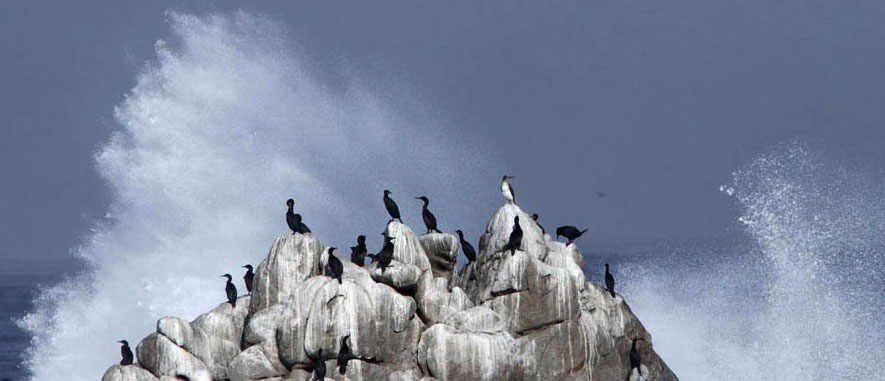
|
| I moved to Pacific Grove, California, in 1979, and have lived within block of Pt. Pinos since then. Sea-watching can be superb there, and over the next 40 years I've seen five species of Sula on the offshore rocks at Pt. Pinos, as was this Blue-footed Booby (above) among Brandt's Cormorants as a huge wave hits in Oct 2013. Photos of boobies at Pt. Pinos are often distant, but Red-foooted (near right) was not so distant at Hopkins Marine Station, Pacific Grove, in June 2020, and this adult female Brown Booby (far right) was preening not far away on the Coast Guard jetty at Monterey harbor in Jan 2007. |
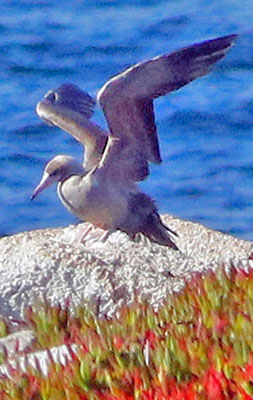 |
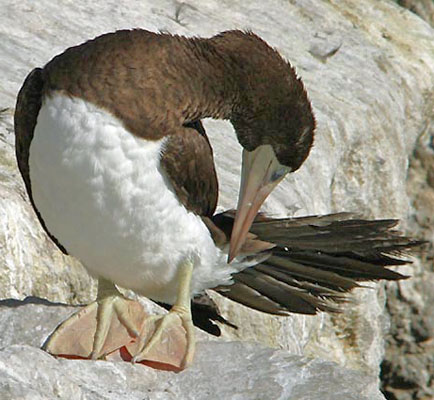 |
|
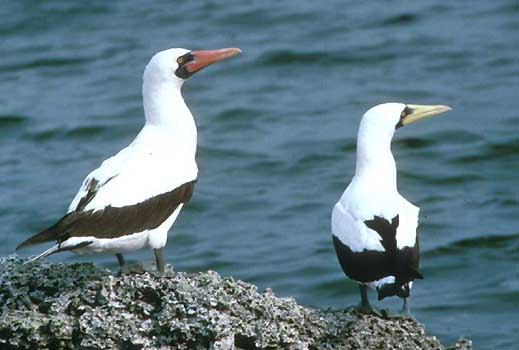 In 1989 I spent four months at sea on a NOAA research cruise in the eastern tropical Pacific. The world's foremost expert on tropical cetaceans and birds, Bob Pitman, had told me to particularly watch for variation in "Masked" Boobies. He believed there were two species involved: the orange-billed Nazca Booby and the yellow-billed Masked Booby (at left is Bob Pitman's great photo of the two side-by-side on Clipperton I., one of the few places where assortative nesting occurs). Bob's research led to the major publication that split these two taxa into two species (Pitman & Jehl 1998). I took notes and photos on my NOAA cruise, plus museum & literature research thereafter, leading to my identification paper on this topic (Roberson 1998). As adults, Nazca Booby has a reddish-pink to orange bill, and also often has white central rectrices (as in Bob's photo); Masked Booby is always yellow-billed and black-tailed. Nazca Booby is endemic to islands on the Nazca tectonic plate (primarily the Galapagos) while the Masked Booby nests on tropical islands around the world. In 1989 I spent four months at sea on a NOAA research cruise in the eastern tropical Pacific. The world's foremost expert on tropical cetaceans and birds, Bob Pitman, had told me to particularly watch for variation in "Masked" Boobies. He believed there were two species involved: the orange-billed Nazca Booby and the yellow-billed Masked Booby (at left is Bob Pitman's great photo of the two side-by-side on Clipperton I., one of the few places where assortative nesting occurs). Bob's research led to the major publication that split these two taxa into two species (Pitman & Jehl 1998). I took notes and photos on my NOAA cruise, plus museum & literature research thereafter, leading to my identification paper on this topic (Roberson 1998). As adults, Nazca Booby has a reddish-pink to orange bill, and also often has white central rectrices (as in Bob's photo); Masked Booby is always yellow-billed and black-tailed. Nazca Booby is endemic to islands on the Nazca tectonic plate (primarily the Galapagos) while the Masked Booby nests on tropical islands around the world.
The challenge I undertook in my research was attempting to present criteria for the identification of boobies in juvenal or subadult plumages. Boobies do not begin molt for the first 6-8 months of life. The at-sea booby (below) is in juvenal plumage — no primary molt has begin — and in its chocolate-brown plumage looks superficially like an adult Brown Booby. It is a juvenile Nazca Booby. It already has a yellow eye (Brown Boobies are dark-eyed). It lacks the broad white cervical collar which is characteristic of most juvenal Masked Boobies, and this individual is already changing bill color. Both species start out with gray bills and both species eventually become yellow at the tip so the important area is at the base of the bill. In Masked Booby this area gradually changes from gray to greenish-yellow to bright yellow; in Nazca Booby the base of the bill changes from gray to dusty-rose to pale lavender to pinkish-orange and then to bright orange or reddish-pink.
Between July 2017 and Oct 2021, both juvenile and adult Nazca Boobies have been on Pt. Pinos or diving nearby, as has a subadult Masked Booby, thus rounding out the set of five boobies at Pt. Pinos. |
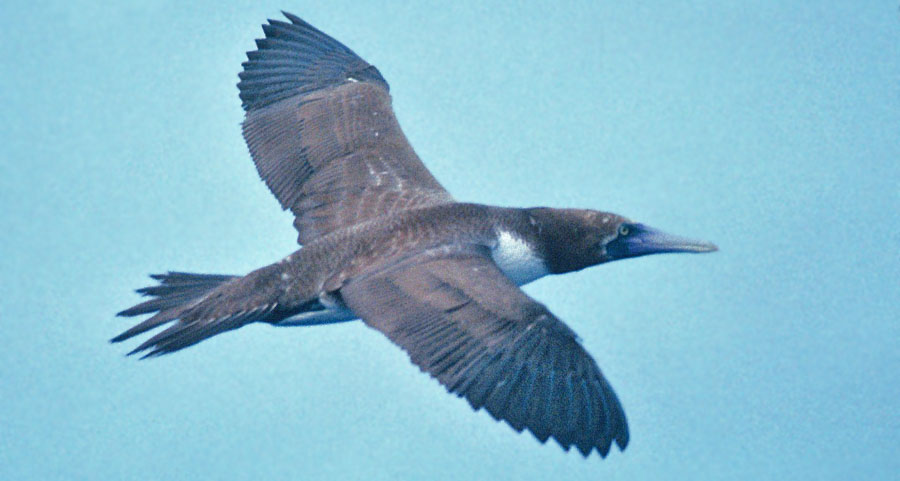 |
Traditionally, the Sulidae was included in the order Pelecaniformes but molecular research suggests otherwise. Support is strong for the monophyly of a group that includes Sulidae (boobies), Phalacrocoracidae (cormorants), Anhingidae (darters), and Fregatidae (frigatebirds; Sibley & Ahlquist 1990, Ericson et al. 2006, Hackett et al. 2008). Both the AOC and the SACC and moved Sulidae, Phalacrocoracidae, Anhingidae, and Fregatidae from the Pelecaniformes and placed them in their own new order, Suliformes. The monophyly of the Sulidae as a family has never been seriously questioned and is supported with genetic data (Friesen & Anderson 1997).
|
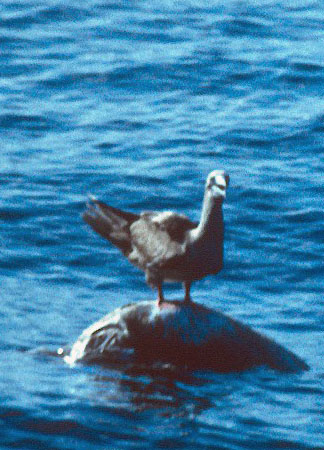 |
Tropical boobies forage across the vast distances of equatorial seas, catching a ride or a rest on the flotsam of the sea. I've seen Brown and Red-footed Boobies riding on discarded paddles, driftwood, and even the carcasses of dead sea-turtles (left: a Red-footed Booby on a deceased Pacific Ridley). Red-foots are really cool birds because they rely heavily on flying fish to survive. Often at sea, days away from any land, we would have a cadre of Red-foots circling the ship, waiting for us to flush a flying-fish into flight (below). They would then dash after the glider, trying to snatch it before it re-submerged. Fun for all! One rode our ship's mast each night for days and hundreds of miles.
The two species of Sula boobies endemic to southern oceans are Peruvian Booby (right), from the Peru Current off western South America, and Abbott's Booby Sula abbotti from Christmas Island in the Indian Ocean. |
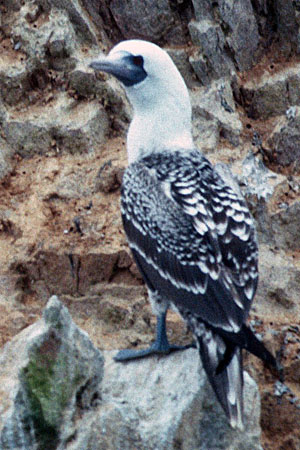 |
|
 |
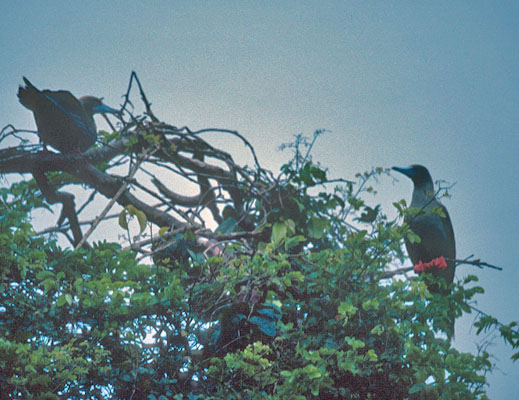 Sulids can present exceptional panoramas of abundant bird life. An island full of Masked Boobies stretching to the horizon is an impressive and noisy place (above, a shot of Clipperton Island by Robert L. Pitman; a few scattered Brown Boobies are also present). Likewise, the crowed rock ledges of any gannet breeding colony is an awe-inspiring and noisy tableau (below; one ledge of Australasian Gannets in New Zealand). Sulids can present exceptional panoramas of abundant bird life. An island full of Masked Boobies stretching to the horizon is an impressive and noisy place (above, a shot of Clipperton Island by Robert L. Pitman; a few scattered Brown Boobies are also present). Likewise, the crowed rock ledges of any gannet breeding colony is an awe-inspiring and noisy tableau (below; one ledge of Australasian Gannets in New Zealand).
Most species nest on the ground, and gannets on rocky ledges, but the Red-footed Booby and Abbott's Booby nest primarily in short bushes and trees (right, Red-footed Boobies in a tree-top colony on Cocos Island, west of Costa Rica.
Sulids do not breed until they are 2-6 years old, depending on the species. Boobies lack a brood patch (it would interfere with aerodynamics in flight) but, instead, have highly vascularized feet. Although birds on nesting islands seem to be sitting on their eggs during incubation (as do other types of birds), they are, in fact, warming them with the webs of their feet! A nice summary of sulid biology is in Carboneras (1992). |
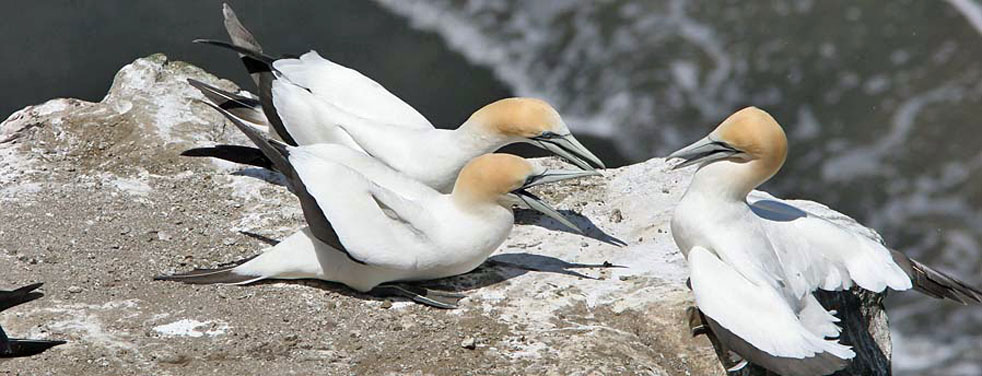 |
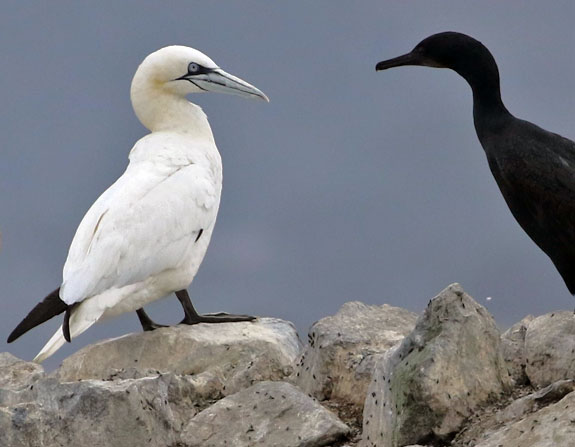 Gannets are circumpolar in southern tropical and temperate oceans, but the last gannet known from the north Pacific Ocean became a fossil in the late Pleistocene. That was true until 25 April 2012, when biologists on SE Farallon Is. saw and photographed one in flight there, the first known record of a Gannet for the entire north Pacific Ocean. The adult Northern Gannet took up residence on the Farallones for some time, then began appearing at Alcatraz in San Francisco Bay, and then along the central California coast from as far north as Pt. Reyes to as far south as Año Nuevo SP. Birders on a pelagic trip in Oct 2021 were thrilled to see it sitting on the rocky jetty at the port of Half Moon Bay as the boat returned to the harbor (left; a fine shot by Dean LaTray). Gannets are circumpolar in southern tropical and temperate oceans, but the last gannet known from the north Pacific Ocean became a fossil in the late Pleistocene. That was true until 25 April 2012, when biologists on SE Farallon Is. saw and photographed one in flight there, the first known record of a Gannet for the entire north Pacific Ocean. The adult Northern Gannet took up residence on the Farallones for some time, then began appearing at Alcatraz in San Francisco Bay, and then along the central California coast from as far north as Pt. Reyes to as far south as Año Nuevo SP. Birders on a pelagic trip in Oct 2021 were thrilled to see it sitting on the rocky jetty at the port of Half Moon Bay as the boat returned to the harbor (left; a fine shot by Dean LaTray).
Northern Gannet are known to live at least 25 years in the wild (Nelson 1978). It was an adult when it first arrived — probably through the "northwest passage" which global warming as cleared of ice in the summer — and this one has been here for almost ten years now.
For me, seeing this Northern Gannet on the Farallones in Sep 2012 brought me full circle with California sulids. My first, as discussed above, was a Blue-footed Booby at the Salton Sea in Nov 1971 (still listed as my 2d most memorable State bird chase). The Farallon gannet was my 600th bird for California, almost on my list of memorable chases, some 41 years later. In between, I was able to publish research on the Masked v. Nazca Booby identification topic.
So I leave you with a couple of sulid flight shots: an adult Masked Booby from the middle of the equatorial Pacific (below, top photo) and an adult Australasian Gannet from New Zealand (below, bottom photo). Enjoy these spectacular, wandering seabirds!
|
|
| |
Photos: The slice of a colony of Cape Gannet Morus capensis was photographed at Lamberts Bay, South Africa, on 6 July 2005. The light-morph Red-footed Booby Sula sula was in the equatorial tropical Pacific at 19°N, 114°W, on 2 Aug 1989. The dark-morph Red-footed Booby Sula sula was at Seacliff SB, Santa Cruz Co., California, on 8 Nov 2015. The first vagrant Blue-footed Booby Sula nebouxii was at Salton City, Imperial Co., California, on 6 Nov 1971; the second vagrant Blue-footed Booby Sula nebouxii, with me, as at New Hogan Reservoir, Calaveras Co., California, on 24 Sep 1976 (photo snapped by Donna Dittmann with my camera). The vagrant Blue-footed Booby Sula nebouxii with huge wave was at Pt. Pinos, Monterey Co., California, on at 8 Oct 2013. The dark-morph Red-footed Booby Sula sula with iceplant was at Hopkins Marine Station, Pacific Grove, California, on 10 June 2020; the adult Brown Booby Sula leucogaster was preening on the Coast Guard jetty at Monterey harbor on 21 Jan 2007. The photo of an adult Nazca Booby Sula granti next to an adult Masked Booby Sula dactylatra was taken by Robert L. Pitman on Clipperton I., in the eastern Pacific, in May 1987. The juvenal-plumaged Nazca Booby Sula granti was in flight over the eastern Pacific was about 350 miles southwest of Baja California on 2 Aug 1989. The dark-morph Red-footed Booby Sula sula sitting on a dead Pacific Ridley was at 9°12'N, 87°03'W, on 9 Nov 1989. The Peruvian Booby Sula variegata was on the Ballestas Is., off the Paracas Peninsula, Peru, on 12 July 1987. Robert L. Pitman's panorama photo of the colony of Masked Booby Sula dactylatra on Clipperton I. is from May 1987. The two dark-morph Red-footed Booby Sula sula atop a nesting colony tree on Cocos I., west of Costa Rica, was taken on 1 Nov 1989. The colony of Australasian Gannet Morus serrator was at Muriway, North Island, New Zealand, on 12 Nov 2009, as was the adult in flight which is the final shot on the page. The long-staying adult Northern Gannet Morus bassanus, the first one known from the north Pacific Ocean, was photographed by Dean LaTray at Half Moon Bay, San Mateo Co., California, on 23 Oct 2021. The flying adult Masked Booby Sula dactylatra was in the tropical eastern Pacific at 13°N, 117°W, on 5 Aug 1989.
All photos © Don Roberson, except those attributed to Robert L. Pitman and Dean LaTray, who holds those copyrights (used with permission); all rights reserved.
Family book: 
Nelson, J. Bryan. 1978. The Sulidae: Gannets and Boobies. Aberdeen Univ. Stud. Ser. 154. Oxford Univ. Press, Oxford.
At 1012 pages, this is the thickest book I own! It was an attempt to set out, in leisurely detail, everything that was then-known about the boobies of the world. It is totally unlike any other family book — it is intended to be and is a major research tool. Every species has a complete account of every nesting island, with long dissertations of breeding biology and ecology, and extensive details on behaviors (especially breeding displays). A few color plates (photos) and many black-and-white photos are scattered throughout. It is an indispensable book for those studying this family. And yet it is strangely unfulfilling. Although the plumage and soft part details are lengthy, there is no real attempt to get at questions of field identification. It does very little good to have a long list of bill or foot colors from the various populations around the world unless those details are tied down to specifics: at what age and in what population are the feet yellow versus green, etc., etc. Nelson seems to regurgitate everything that anyone has ever said about boobies without trying to sift the wheat from the chaff. In doing so, he overlooks those details that Pitman & Jehl (1998) would later use to show that the "Masked" Boobies on the Galapagos are a different species. The photos in Nelson's own book sometimes show important and definitive characters that are overlooked in the text, ncluding the lack of cervical collars on Galapagos juvenile boobies. And despite the huge length, there really is not nearly enough about the breeding phenology of each individual island population, details which could lead to new understanding of vagrancy. There are no color plates aimed at side-by-side identification of species. In its own way, it is a wonderful book, and yet so much is lacking. One must turn to something like Carboneras (1992) — or one of the modern field guides to seabirds — for a field guide approach to worldwide boobies. Yet those texts are rather weak on inter-island populations, and Carboneras (1992) totally overlooked the orange-billed boobies on the Galapagos, later split as Nazca Booby.
Literature cited:
Carboneras, C. 1992. Family Sulidae (Gannets & Boobies), pp. 312–325 in Handbook of the Birds of the World (del Hoyo, J., A. Elliott & J. Sargatal, eds). Vol. 1. Lynx Edicions, Barcelona, Spain.
Elliott, B. G. 1976. Blue-footed Booby in northern California. W. Birds 7: 155-157.
Ericson, P.G.P., C.L. Anderson, T. Britton, A. Elzanowski, U.S. Johansson, M. Källersjö, J.I. Ohlson, T.J. Parsons, D. Zuccon, and G. Mayr. 2006. Diversification of Neonaves: integration of molecular sequence data and fossils. Biol. Letters 2: 543–547.
Fain, M. G., and P. Houde. 2004. Parallel radiations in the primary clades of birds. Evolution 58: 2558–2573.
Hackett, S.J., R.T. Kimball, S. Reddy, R.C.K. Bowie, E.L. Braun, M.J. Braun, J.L. Chojnowski, W.A. Cox, K. Han, J. Harshman, C.J. Huddleston, B.D. Marks, K.L. Miglia, W.S. Moore, F.H. Sheldon, D.W. Steadman, C.C. Witt, and T. Yuri. 2008. A phylogenomic study of birds reveals their evolutionary history. Science 320: 1763–1768.
Friesen, V.L., and D.J. Anderson. 1997. Phylogeny and evolution of the Sulidae (Aves: Pelecaniformes): a test of alternative modes of speciation. Molec. Phylog. Evol. 7: 252–260.
McCaskie, G. 1970. The occurrence of four species of Pelecaniformes in the southwestern United States. Calif. Birds 1: 117–142.
Nelson, J. Bryan. 1978. The Sulidae: Gannets and Boobies. Aberdeen Univ. Stud. Ser. 154. Oxford Univ. Press, Oxford.
Pitman, R. L., and J. R. Jehl, Jr. 1998. Geographic variation and reassessment of species limits in the "Masked" Boobies of the eastern Pacific Ocean. Wilson Bull. 110: 155–170.
Roberson, D. 1998. Sulids Unmasked: which large booby reaches California. Field Notes 52: 276–287; available on-line, but (oddly) although the original article was published in full color, half the pages reproduced in this pdf are in black-and-white.
Sibley, C.G., and J.E. Ahlquist. 1990. Phylogeny and Classification of Birds: a Study of Molecular Evolution. Yale Univ. Press, New Haven, CT.
|
|
|



 In 1989 I spent four months at sea on a NOAA research cruise in the eastern tropical Pacific. The world's foremost expert on tropical cetaceans and birds, Bob Pitman, had told me to particularly watch for variation in "Masked" Boobies. He believed there were two species involved: the orange-billed Nazca Booby and the yellow-billed Masked Booby (at left is Bob Pitman's great photo of the two side-by-side on Clipperton I., one of the few places where assortative nesting occurs). Bob's research led to the major publication that split these two taxa into two species (Pitman & Jehl 1998). I took notes and photos on my NOAA cruise, plus museum & literature research thereafter, leading to my identification paper on this topic (Roberson 1998). As adults, Nazca Booby has a reddish-pink to orange bill, and also often has white central rectrices (as in Bob's photo); Masked Booby is always yellow-billed and black-tailed. Nazca Booby is endemic to islands on the Nazca tectonic plate (primarily the Galapagos) while the Masked Booby nests on tropical islands around the world.
In 1989 I spent four months at sea on a NOAA research cruise in the eastern tropical Pacific. The world's foremost expert on tropical cetaceans and birds, Bob Pitman, had told me to particularly watch for variation in "Masked" Boobies. He believed there were two species involved: the orange-billed Nazca Booby and the yellow-billed Masked Booby (at left is Bob Pitman's great photo of the two side-by-side on Clipperton I., one of the few places where assortative nesting occurs). Bob's research led to the major publication that split these two taxa into two species (Pitman & Jehl 1998). I took notes and photos on my NOAA cruise, plus museum & literature research thereafter, leading to my identification paper on this topic (Roberson 1998). As adults, Nazca Booby has a reddish-pink to orange bill, and also often has white central rectrices (as in Bob's photo); Masked Booby is always yellow-billed and black-tailed. Nazca Booby is endemic to islands on the Nazca tectonic plate (primarily the Galapagos) while the Masked Booby nests on tropical islands around the world. 


 The Sulidae are large seabirds found around the globe, primarily concentrated towards equatorial waters. All species are strictly marine birds, feeding primarily on fish, and they come ashore only to nest or roost. Sulids are built for a wandering life at sea, and after fledging may not return to the breeding islands for years. They have a buoyant flight on long, strong wings; a maneuverable long wedge-shaped tail; and a cigar-shaped body with a long, sturdy, fish-eating bill (Carboneras 1992).
The Sulidae are large seabirds found around the globe, primarily concentrated towards equatorial waters. All species are strictly marine birds, feeding primarily on fish, and they come ashore only to nest or roost. Sulids are built for a wandering life at sea, and after fledging may not return to the breeding islands for years. They have a buoyant flight on long, strong wings; a maneuverable long wedge-shaped tail; and a cigar-shaped body with a long, sturdy, fish-eating bill (Carboneras 1992).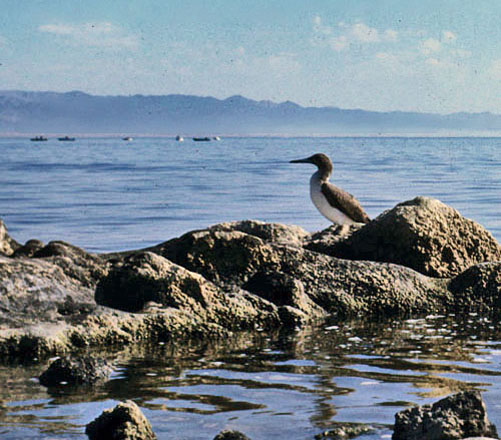
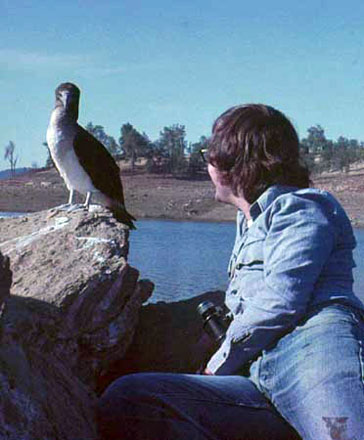





 Sulids can present exceptional panoramas of abundant bird life. An island full of Masked Boobies stretching to the horizon is an impressive and noisy place (above, a shot of Clipperton Island by Robert L. Pitman; a few scattered Brown Boobies are also present). Likewise, the crowed rock ledges of any gannet breeding colony is an awe-inspiring and noisy tableau (below; one ledge of Australasian Gannets in New Zealand).
Sulids can present exceptional panoramas of abundant bird life. An island full of Masked Boobies stretching to the horizon is an impressive and noisy place (above, a shot of Clipperton Island by Robert L. Pitman; a few scattered Brown Boobies are also present). Likewise, the crowed rock ledges of any gannet breeding colony is an awe-inspiring and noisy tableau (below; one ledge of Australasian Gannets in New Zealand). Gannets are circumpolar in southern tropical and temperate oceans, but the last gannet known from the north Pacific Ocean became a fossil in the late Pleistocene. That was true until 25 April 2012, when biologists on SE Farallon Is. saw and photographed one in flight there, the first known record of a Gannet for the entire north Pacific Ocean. The adult Northern Gannet took up residence on the Farallones for some time, then began appearing at Alcatraz in San Francisco Bay, and then along the central California coast from as far north as Pt. Reyes to as far south as Año Nuevo SP. Birders on a pelagic trip in Oct 2021 were thrilled to see it sitting on the rocky jetty at the port of Half Moon Bay as the boat returned to the harbor (left; a fine shot by Dean LaTray).
Gannets are circumpolar in southern tropical and temperate oceans, but the last gannet known from the north Pacific Ocean became a fossil in the late Pleistocene. That was true until 25 April 2012, when biologists on SE Farallon Is. saw and photographed one in flight there, the first known record of a Gannet for the entire north Pacific Ocean. The adult Northern Gannet took up residence on the Farallones for some time, then began appearing at Alcatraz in San Francisco Bay, and then along the central California coast from as far north as Pt. Reyes to as far south as Año Nuevo SP. Birders on a pelagic trip in Oct 2021 were thrilled to see it sitting on the rocky jetty at the port of Half Moon Bay as the boat returned to the harbor (left; a fine shot by Dean LaTray). 